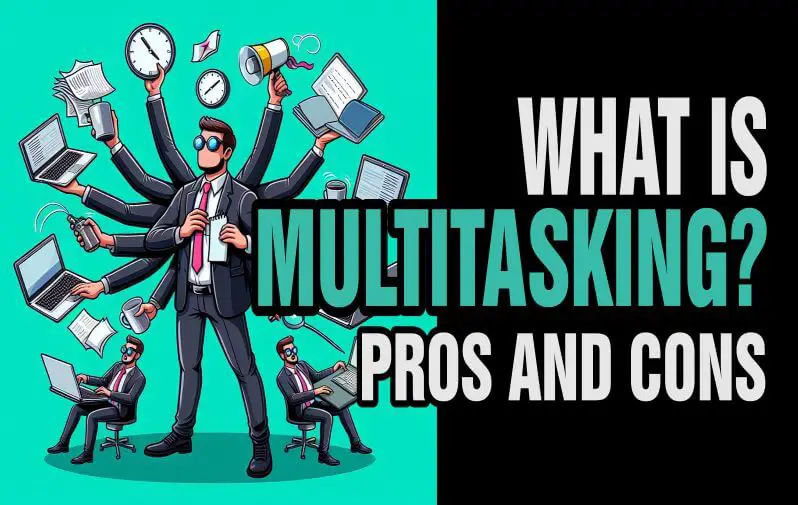Last updated on February 2nd, 2025 at 04:16 am
What is multitasking? Explore the concept of multitasking or juggling multiple tasks at a time and its impact on productivity and mental well-being.
Multitaskers have always been regarded as smart people as they can complete multiple tasks at the same time. But trouble brewing!
The ability to handle multiple tasks simultaneously is a skill highly valued in today’s fast-paced world.
While it may seem like a productivity booster, its effects on efficiency and mental well-being are a subject of debate.
Understanding the pros and cons of handling multiple tasks at a time is crucial for individuals striving to optimize their performance.
This article will reach deep into what task-juggling is, and the potential benefits and drawbacks, shedding light on whether it is truly advantageous or detrimental to your overall effectiveness.
Related: 10 Task Juggling Skills You Should Master
Table of Contents
- What is Multitasking?
- Is Multitasking a Myth or is it Possible?
- The Impact of Multitasking on Job Performance
- Are Women Better at Multitasking?
- Pros and Cons of Multitasking
- Examples of Multitasking
- Types of Multitasking
- Multitasking and Technology
- Multitasking in Different Areas of Life
- Finding Balance: How to Handle Multiple Tasks Without Losing Focus
- Why is Multitasking Dangerous to Memorization?
- How to Stop Multitasking and Get More Done
- Multitasking Test
- Frequently Asked Questions
- Final Thoughts
What is Multitasking?
Multitasking Definition
Handling multiple tasks at a time is the ability to perform multiple tasks at the same time or to switch rapidly between two or more tasks.
It has become a defining feature of our modern society, where people are constantly attempting to balance work, personal life, and technology.
Handling multiple tasks at a time is often seen as a desirable skill to have, particularly in the workplace, where the ability to juggle, multiple tasks may lead to increased productivity and efficiency.
Organizations may demand that employees juggle multiple tasks simultaneously, or individuals may feel pressure to check their phones or engage in other distractions constantly.
As technology continues to evolve and the pace of life continues to accelerate, the practice of juggling tasks will likely continue to be a defining feature of modern society.
Related: Your Brain Depreciates with Multitasking
Is Multitasking a Myth or is it Possible?

There is an ongoing debate among experts about the concept of simultaneous tasking.
Some argue that humans are not capable of true juggling, as our brains can only actively focus on one task at a time.
They argue that what we perceive as multiple-tasking is rapidly switching your attention between different activities.
Others, however, believe that humans can multitask to some extent, particularly when the tasks involve different areas of the brain.
Research suggests that attempting to multitask can lead to reduced productivity and increased errors due to divided attention.
When you switch between tasks, your brain needs time to refocus, which can result in inefficiency.
Therefore, while it may seem like we can do multiple things simultaneously, it is likely that the brain is simply alternating attention between tasks, making juggling tasks more of a myth than a reality.
Related: Helping Teenagers in Balancing Multitasking
The Impact of Multitasking on Job Performance
Of course, handling multiple tasks at a time impacts job performance either positively or negatively.
Let’s take a closer look at this:
Time Management Challenges and Potential Burnout
Handling multiple tasks at a time can lead to time management challenges, as individuals may struggle to allocate sufficient attention to each task.
This can result in increased stress and potential burnout, particularly if employees consistently feel overwhelmed by the volume of tasks they are expected to manage.
Decreased Creativity and Innovation
Dividing attention across multiple tasks can hinder deep focus and creative thinking.
Employees may find it challenging to generate innovative ideas or problem-solve effectively when their attention is divided among various responsibilities.
Increased Stress and Decreased Job Satisfaction
Juggling can contribute to heightened stress levels, as you may feel pressure to switch between tasks and meet competing deadlines constantly.
This can lead to decreased job satisfaction and overall well-being.
Lowers the Intelligence Quotient (IQ)
Another research approached the subject from another angle of lowering the human IQ apart from slowing you down.
A University of London study discovered that participants who multitasked at a cognitive task had a decline in IQ score that resembled what was expected when marijuana is consumed or the effect experienced when stayed awake at night.
It stressed that task-juggling dropped men’s IQ to that of an 8-year-old child. It could be observed that handling multiple tasks in a gathering makes a person absent-minded to a task while appearing confused at another and this indicates low social awareness, an emotional smartness (EQ) component that is necessary for success wherever.
Also Read: Understanding Intellectual Curiosity
Are Women Better at Multitasking?
A study published in BMC Psychology conducted by UK psychologists found that men were slower and less organized than women when switching between tasks quickly.
Both sexes struggled with balancing priorities, but men faced more challenges overall.
Dr. Gijsbert Stoet of the University of Glasgow suggested that if men are indeed slower at handling multiple tasks at once, it could impact workplace expectations.
The issue of juggling tasks has become increasingly important in the workplace, but interruptions can significantly affect productivity.
Previous research has produced varied results on gender and handling multiple tasks at once, with some studies showing women outperforming men and others suggesting men may excel in certain juggling task scenarios.
In the study, both men and women slowed down and made more errors as the switching between tasks accelerated, but men exhibited a 77% longer response time compared to women’s 69%.
See more reports on this by BBC.
Pros and Cons of Multitasking
Pros
Though juggling tasks is believed to be detrimental to the brain, here are the advantages of combining tasks:
Increased Productivity: It allows people to accomplish more tasks in a shorter amount of time. By working on several tasks simultaneously, individuals can complete more work than they would have been able to by focusing on one task at a time.
Better Time Management: Requires individuals to prioritize tasks and manage their time effectively. This skill is valuable in both personal and professional settings.
Improved Cognitive Skills: It can help improve cognitive skills, such as attention, memory, and executive function. Several studies have shown that individuals who regularly multitask have better mental agility and can quickly shift their attention between tasks.
Flexibility: Juggling tasks requires individuals to be flexible and adaptable in their approach to completing tasks. This skill can be beneficial in the workplace, where unforeseen challenges and changes often arise.
Increased Efficiency: When you multitask, you can work more efficiently by completing small tasks during downtime or breaks between more significant projects. This can help prevent wasted time and increase overall productivity.
Cons
Here are the disadvantages of juggling tasks:
Decreased Productivity: Studies have shown that attempting to juggle multiple tasks can decrease overall productivity, as the brain becomes overwhelmed and unable to focus effectively on any one thing.
Reduced Creativity: Juggling tasks can reduce the ability to think creatively and develop new ideas, as the brain is constantly switching and unable to fully engage with any one task.
Increased Stress Levels: Trying to do too many things at once can lead to increased stress levels, as the brain is working overtime to process all the information and demands being thrown its way.
Impaired Decision-making: When handling multiple tasks, it can be difficult to make informed decisions, as the brain is pulled in multiple directions and may not be able to give each decision the necessary attention.
Reduced Work Quality: Attempting to multitask can lead to errors and oversights, resulting in lower-quality work and potentially costly mistakes.
Examples of Multitasking

Here are a few examples:
- Working While Attending a Conference Call: You listen, take notes, answer emails, or complete tasks simultaneously, balancing communication with productivity during remote meetings.
- Cooking While Watching TV: You follow recipes, monitor food, and enjoy entertainment, making meal preparation more engaging without fully dividing your attention.
- Texting While Walking: You communicate while moving, staying connected on the go, though this may reduce awareness of your surroundings and safety.
- Exercising While Listening to an Audiobook: You stay active while absorbing information or entertainment, making workouts more engaging and mentally stimulating.
- Studying With Background Music: Soft music can create a calming study environment, improving focus for some while being distracting for others.
- Chatting with Friends While Doing Household Chores: You stay socially connected while completing tasks, making mundane activities feel less tedious and more enjoyable.
Types of Multitasking
Task juggling can be broadly categorized into two main types: simultaneous multitasking and task-switching multitasking.
Let’s take a look:
1. Simultaneous Multitasking
Simultaneous task juggling refers to performing multiple tasks at the same time.
This type of task juggling involves dividing attention between multiple activities simultaneously.
Examples include:
Physical Multitasking: Physical task juggling involves the simultaneous performance of multiple physical tasks. For instance, carrying groceries while talking on the phone.
Cognitive Multitasking: Cognitive task juggling involves performing multiple mental tasks simultaneously. It might include studying while listening to music or watching TV.
Parallel Multitasking: Parallel task-juggling refers to running multiple processes concurrently on a computer. For example, using multiple software applications simultaneously or downloading files while browsing the internet.
2. Task-Switching Multitasking
Task-switching involves switching between multiple tasks or activities rapidly.
Instead of performing tasks simultaneously, this type focuses on switching attention between different tasks sequentially.
Examples include:
Context-switching: Switching between tasks like emails, meetings, and projects throughout the day can reduce focus and slow progress by constantly shifting mental gears.
Interruption-driven Multitasking: External disruptions like calls, messages, and sudden requests force attention shifts, making it harder to complete tasks efficiently and maintain deep focus.
Priority-based Multitasking: Managing tasks by importance requires constant reassessment, shifting focus as priorities change, and ensuring urgent and essential work gets done first without unnecessary distractions.
Multitasking and Technology

Technology plays a big part in influencing how you multitask. Let’s take a closer look at the following factors:
Technology provides various tools, devices, and platforms that enable you to handle multiple tasks simultaneously.
For example, smartphones, tablets, and laptops allow you to access various applications, complete different assignments, and communicate with others all at once.
This has led to an increase in the expectation and ability to multitask in both personal and professional settings.
The Influence of Social Media and Smartphones
Social media platforms and smartphones have had a profound influence on task-juggling behaviors.
These technologies have made it easier for individuals to engage in multiple activities simultaneously, such as checking emails, texting, browsing the internet, and using social media while listening to music or watching videos.
It has become common for people to switch between different applications or tasks rapidly, often driven by notifications and constant connection to social networks.
How Technology Affects Multitasking Abilities
While technology has made handling multiple tasks at a time more accessible, it has also been found to negatively impact your task-juggling abilities.
Studies have shown that frequent multitaskers, influenced by technology, may experience reduced attention span, decreased cognitive performance, and difficulties in maintaining focus on a single task.
The constant switching between tasks can lead to a decrease in productivity and quality of work, as attention is divided across multiple activities.
Potential Addictive Nature of Handling Multiple Tasks at a Time
Task juggling, facilitated by technology, can become addictive due to the constant stimulation and reward systems associated with completing tasks or receiving notifications.
The instant gratification provided by checking social media updates or receiving messages can lead to a compulsive need to continuously engage in multiple activities simultaneously.
This addictive nature can result in a decrease in well-being, increased stress levels, and hindered personal relationships as you struggle to break away from the task-juggling habit.
Multitasking in Different Areas of Life
Multitasking happens everywhere, at work, in school, at home, and even in relationships.
Sometimes, it helps you get things done faster. Other times, it hurts focus and lowers the quality of your work.
The key is knowing when to juggle tasks and when to give something your full attention.
Multitasking at Work
Work can feel like a constant balancing act. You might be answering emails, attending meetings, reviewing reports, and managing projects, all at the same time.
While switching between tasks can boost efficiency, it can also cause distractions and lead to mistakes.
To make multitasking work for you:
✔ Prioritize tasks based on urgency and importance.
✔ Use time-blocking to focus on one thing at a time.
✔ Minimize interruptions by silencing notifications when deep focus is needed.
Multitasking in Education
Studying while listening to a lecture, researching while working on an assignment, or taking notes during a discussion—these are all common ways students juggle tasks. While it can save time, too much task-switching can lower concentration and make it harder to retain information.
To multitask wisely in education:
✔ Combine passive and active tasks, like listening to an audiobook while reviewing notes.
✔ Avoid distractions like social media when studying.
✔ Take breaks to refresh your mind and improve focus.
Multitasking in Daily Life
Everyday life is full of opportunities to handle multiple tasks at once. You might cook while cleaning, listen to a podcast while commuting, or reply to messages while eating. While this can save time, it’s easy to overload yourself and lose focus on what matters.
To multitask effectively in daily life:
✔ Choose simple, low-focus tasks to combine, like folding laundry while watching TV.
✔ Avoid splitting attention when safety or accuracy is needed, like driving while texting.
✔ Set aside distraction-free moments to enjoy activities fully.
Multitasking in Personal Relationships
It’s easy to fall into the habit of checking your phone while talking to a loved one or watching TV while having dinner together.
However, divided attention can weaken connections and make conversations feel shallow.
To keep relationships strong:
✔ Put devices away when spending time with loved ones.
✔ Be fully present during conversations.
✔ Prioritize quality time over task-juggling when it matters most.
Finding Balance: How to Handle Multiple Tasks Without Losing Focus
Handling multiple tasks at once can be tricky. Sometimes, it helps you get more done, but other times, it just leads to stress and mistakes.
The key is knowing when to multitask and when to focus. Here’s how to find that balance:
1. Know When Task-Switching Works—And When It Doesn’t
Not all tasks require full concentration. You can listen to a podcast while cleaning or check emails during a low-effort task.
But studying, deep conversations, or problem-solving need your undivided attention.
Before juggling tasks, ask yourself: Will doing both at once lower the quality of my work? If the answer is yes, it’s time to focus.
2. Understand Your Own Multitasking Limits
Some people naturally shift between tasks without losing efficiency, while others struggle and end up less productive.
Pay attention to your work habits. Do you find yourself making mistakes or feeling drained when multitasking? If so, sticking to one task at a time might be the smarter approach.
3. Use Mindfulness to Stay Present
Your brain works best when it’s not overloaded. Mindfulness helps you stay focused even when switching between tasks.
Try deep breathing, meditation, or simply setting an intention before starting work. Training your mind to stay in the moment makes it easier to manage tasks without feeling scattered.
4. Set Boundaries with Technology
Constant notifications and social media make multitasking harder than it needs to be. Instead of letting technology pull your attention in different directions, take control:
- Schedule specific times to check emails and messages.
- Turn off non-essential notifications.
- Set “no-screen” periods to stay fully engaged in important tasks.
Why is Multitasking Dangerous to Memorization?
Working on multiple tasks at once is dangerous to memorization because it splits your attention and impairs your ability to focus on a single task.
When you engage in multiple activities simultaneously, your brain is constantly switching between tasks, leading to reduced concentration and attention span.
This hampers the encoding of information into your memory systems, making it difficult to retain and recall information later.
The brain requires uninterrupted processing and concentration to form strong neural connections for effective memorization.
Handling multiple tasks at a time diverts cognitive resources and disrupts the consolidation of memories, resulting in poor retention and recall.
Additionally, it often leads to increased stress levels, which further impairs memory function.
Thus, to improve memorization, minimizing distractions and prioritizing focused attention on a single task at a time is crucial.
How to Stop Multitasking and Get More Done
You might think multitasking helps you accomplish more, but it slows you down. It divides your focus, increases mistakes, and drains your mental energy.
If you’re ready to work smarter, not harder, here’s how to break free from multitasking:
1. Notice How Multitasking Hurts You
Be honest—do you feel mentally exhausted but barely make progress? Jumping between tasks lowers your focus and leads to sloppy work. Acknowledge that doing one thing at a time isn’t lazy; it’s how you produce better results with less stress.
2. Prioritize with Purpose
Write down everything on your plate. Which tasks truly matter? Deadlines, urgent projects, and high-impact work should come first. Let go of the habit of treating everything as equally important.
3. Give One Task Your Full Attention
Pick a task and commit to it. Close those extra tabs. Put your phone away. Silence notifications. If something unrelated pops into your head, jot it down for later. The fewer distractions, the faster you’ll finish.
4. Use Time Blocks to Structure Your Day
Instead of bouncing between tasks, assign specific time slots for each. Set aside an hour for emails, a block for deep work, and a break in between. This method trains your brain to focus and prevents the urge to multitask.
5. Try the Pomodoro Technique
Set a timer for 25–30 minutes and work on one task without stopping. When time’s up, take a five-minute break. Repeat this a few times, then rest longer. This trick keeps your mind fresh and helps you work with urgency.
6. Offload What You Can
If your to-do list is overwhelming, delegate. Pass on tasks that someone else can handle. Whether it’s a colleague, an assistant, or an automated tool, clearing unnecessary work frees up your focus.
7. Be Realistic About Your Limits
You can’t do everything in a day—and that’s okay. Set clear expectations for yourself and others. Saying “no” or rescheduling tasks isn’t failure; it’s smart time management.
8. Take Breaks That Refresh You
Breaks aren’t wasted time, they’re refueling stops. Instead of scrolling through your phone, step outside, stretch, or breathe deeply. A clear mind makes focusing on the next task easier.
Multitasking Test
A multitasking test is designed to measure your ability to perform multiple tasks simultaneously or switch between different tasks efficiently.
It evaluates cognitive skills such as attention, memory, and problem-solving while managing various activities concurrently.
Participants are often presented with a variety of activities or stimuli, such as responding to emails, solving puzzles, or listening to instructions, and their performance is assessed based on accuracy, speed, and task-switching abilities.
This type of assessment is frequently used in job selection processes, where the ability to multitask is crucial, such as in administrative or managerial roles.
Frequently Asked Questions
What do you mean by multitasking?
It refers to the ability to perform multiple tasks or activities simultaneously or in rapid succession.
What is the meaning of multitasker?
A multitasker is a person who can efficiently handle and switch between multiple tasks or activities without losing productivity or quality.
What is the definition of multitasking in the workplace?
In the workplace, it involves managing and executing multiple tasks or projects simultaneously, often requiring quick transitions between different responsibilities.
Final Thoughts
Multitasking is a complex skill that offers both advantages and disadvantages.
While it can increase productivity in certain situations, it may also lead to decreased efficiency and heightened stress.
Understanding when to multitask and when to focus on single tasks is crucial.
By recognizing the potential trade-offs and learning to prioritize effectively, you can harness the benefits of juggling tasks while mitigating their drawbacks, ultimately optimizing your overall performance and well-being.
References:
- Understanding task juggling
- Meaning of task juggling
- Everything to know about handling multiple tasks at a time
Pyo Merez (PsyD) is a distinguished adolescent and adult psychologist at the forefront of mental health advocacy.
With expertise in cognitive and developmental psychology, focusing on social relationships, cultural contexts, and individual differences, Pyo has dedicated his career to empowering adolescents and adults.
As a sought-after speaker and panelist, Pyo shares invaluable insights on issues affecting young people, contributing to a deeper understanding of mental health and well-being in today's society.


